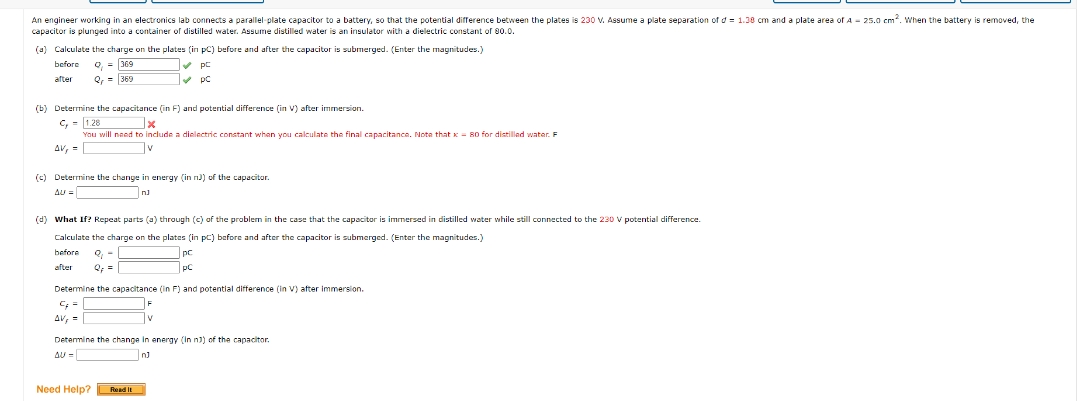An engineer working in an electronics lab connects a parallel plate capacitor to a battery, so that the potential difference between the plates is 230 V. Assume a plate separation of d= 1.30 cm and a plate area of A - 25.0 cm. When the battery is removed, the capacitor is plunged into a container of distilled water. Assume distilled water is an insulator with a dielectric constant of 00.0. (a) Calculate the charge on the plates (in pC) before and after the capacitor is submerged. (Enter the magnitudes.) O - 369 Q,- 369 before v pC after (b) Determine the capacitance (in F) and potential difference (in V) after immersion. C, - 1 28 You will need to include a dielectric constant when you calculate the final capacitance., Nota that k= R0 for distilled water. F AV, (e) Determine the change in energy (in na) of the capacitor. AU =
An engineer working in an electronics lab connects a parallel plate capacitor to a battery, so that the potential difference between the plates is 230 V. Assume a plate separation of d= 1.30 cm and a plate area of A - 25.0 cm. When the battery is removed, the capacitor is plunged into a container of distilled water. Assume distilled water is an insulator with a dielectric constant of 00.0. (a) Calculate the charge on the plates (in pC) before and after the capacitor is submerged. (Enter the magnitudes.) O - 369 Q,- 369 before v pC after (b) Determine the capacitance (in F) and potential difference (in V) after immersion. C, - 1 28 You will need to include a dielectric constant when you calculate the final capacitance., Nota that k= R0 for distilled water. F AV, (e) Determine the change in energy (in na) of the capacitor. AU =
Related questions
Question

Transcribed Image Text:An engineer working in an electronics lab connects a parallel-plate capacitor to a battery, so that the potential difference between the plates is 230 V. Assume a plate separation of d = 1.38 cm and a plate area of A - 25.0 cm. When the battery is removed, the
capacitor is plunged into a container of distilled water. Assume distilled water is an insulator with a dielectric constant of 80.0.
d into
(a) Calculate the charge on the plates (in pC) before and after the capacitor is submerged. (Enter the magnitudes.)
O - 369
Q, = 369
before
V pc
after
v pC
(b) Determine the capacitance (in F) and potential difference (in V) after immersion.
C, - 128
You will naed to include a dielectric constant when you calculate the final capacitance. Nota that x= 80 for distillad water. F
AV, =
(c) Determine the change in energy (in n)) of the capacitor.
Au:
(d) what If? Repeat parts (a) through (c) of the problem in the case that the capacitor is immersed in distilled water while still connected to the 230 V potential difference.
Calculate the charge on the plates (in pc) before and after the capacitor is submerged. (Enter the magnitudes.)
before
pc
after
Q: =
pC
Determine the capacitance (in F) and potential difference (in V) after inmmersion.
AV, =
Determine the change in energy (In n) of the capacitor.
AU =
Need Help?
Read it
Expert Solution
This question has been solved!
Explore an expertly crafted, step-by-step solution for a thorough understanding of key concepts.
Step by step
Solved in 5 steps
